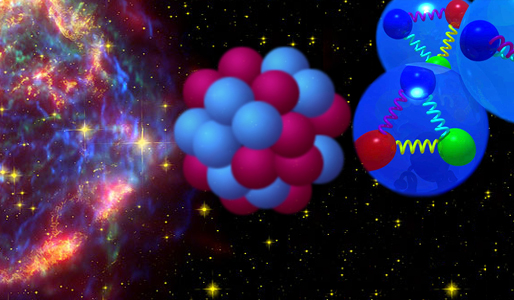Notes 2: Difference between revisions
No edit summary |
No edit summary |
||
| Line 1: | Line 1: | ||
[[Image:Paul1.jpg]] | [[Image:Paul1.jpg]] | ||
Nuclear Astrophysics is a combination of nuclear physics and astrophysics. Nuclear physics is the study of atomic nuclei, their composition and their interactions, while astrophysics aims at studying galactic objects such as stars and galaxies. Nuclear astrophysics delves into the questions of where and when the elements were created and how nuclear reactions drive cosmic events. | '''Nuclear Astrophysics''' is a combination of nuclear physics and astrophysics. Nuclear physics is the study of atomic nuclei, their composition and their interactions, while astrophysics aims at studying galactic objects such as stars and galaxies. Nuclear astrophysics delves into the questions of where and when the elements were created and how nuclear reactions drive cosmic events. | ||
== | ==The Nucleus== | ||
Atomic nuclei sizes are on the scale of <math>10^{-14} </math> meters and form the (relatively) small centers of atoms while carrying most of the mass | Atomic nuclei sizes are on the scale of <math>10^{-14} </math> meters and form the (relatively) small centers of atoms while carrying most of the mass. The basic constituents of atomic nuclei are protons and neutrons. Protons and neutrons are comprised of three quarks each, fundamental particles on a size scale of <math> 10^{-19} m </math>. The relevant interactions on these size/mass scales are the electro-weak and strong forces. The quarks in a nucleon are | ||
Revision as of 15:39, 20 January 2011
Nuclear Astrophysics is a combination of nuclear physics and astrophysics. Nuclear physics is the study of atomic nuclei, their composition and their interactions, while astrophysics aims at studying galactic objects such as stars and galaxies. Nuclear astrophysics delves into the questions of where and when the elements were created and how nuclear reactions drive cosmic events.
The Nucleus
Atomic nuclei sizes are on the scale of meters and form the (relatively) small centers of atoms while carrying most of the mass. The basic constituents of atomic nuclei are protons and neutrons. Protons and neutrons are comprised of three quarks each, fundamental particles on a size scale of . The relevant interactions on these size/mass scales are the electro-weak and strong forces. The quarks in a nucleon are


